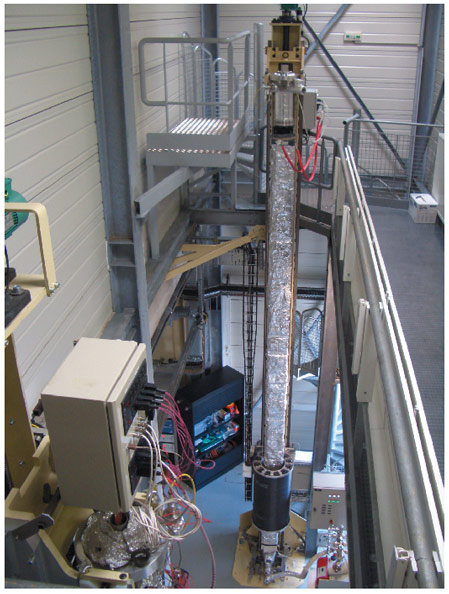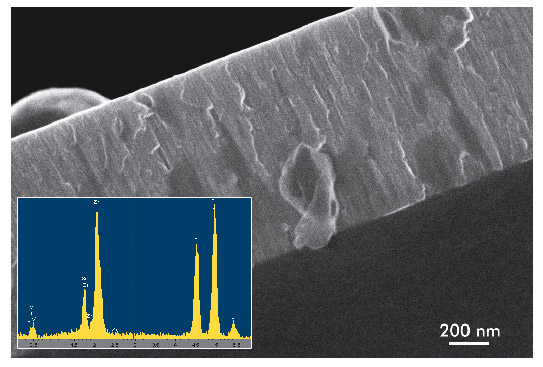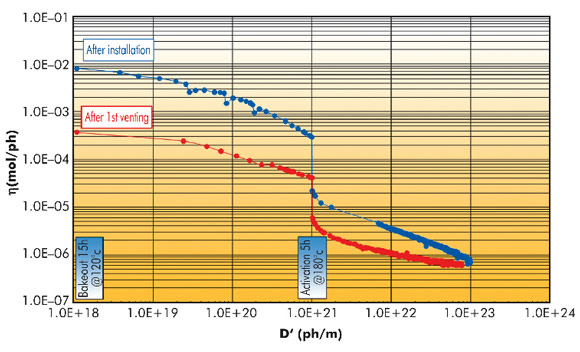- Home
- Users & Science
- Scientific Documentation
- ESRF Highlights
- ESRF Highlights 2010
- Enabling technologies
- Status of NEG coating at the ESRF
Status of NEG coating at the ESRF
Non-evaporable getters (NEG) are materials that exhibit particular behaviour within a vacuum such as a pumping action (gettering) and low molecular desorption yield under electron or photon irradiation. NEG coating is attractive because it can be used for volumes that are difficult to evacuate.
NEG coated insertion device (ID) vacuum chambers have been installed on all available straight sections of the ESRF storage ring. The NEG coating helps to overcome the conductance limitations of these flat vessels by providing distributed pumping across its length as well as lowering its photo desorption yield. These effects induce reduced levels of Bremsstrahlung radiation and permit faster vacuum recovery after maintenance or shut downs.
Since 2002, following collaboration and the purchase of a license from CERN, which holds the TiZrV NEG coating technology patent, the ESRF has been producing NEG coated vacuum chambers using DC magnetron enhanced physical vapour deposition (PVD) in a dedicated coating facility. Initially, two independent coating systems were constructed to coat vacuum chambers up to 5 m in length. Within the ongoing ESRF Upgrade Programme one of these systems was modified to allow the coating of 6.2 m chambers (Figure 147).
 |
|
Fig. 147: NEG coating system for 6.2 m vacuum chambers. |
During production and testing of the first 6.2 m long ID vacuum chambers in 2009 it became apparent that the optimisation of the experimental setup for finer control of the overall coating process was necessary. All steps of the production, quality check, installation and commissioning were reviewed in order to obtain reproducible results with these chambers.
We discovered that the cathode target required guiding inside the chamber to ensure the correct centring over the full length due to the flexibility of their 6-metre long flat extruded profile. The cathodes were positioned with ceramic spacers, which proved determinant to avoid short-circuits and to guarantee a better distribution of the plasma along the chamber.
To monitor quality, scanning electron microscopy (SEM) and energy-dispersive X-ray spectroscopy (EDX) were performed on samples taken from the extremities of the coated chamber (Figure 148). A recent improvement has been the systematic use of non-destructive analysis of the coating using X-ray fluorescence through the chamber walls. The presence of the film is verified by looking through the aluminium substrate for the fluorescence peak of the zirconium (one of the three metals forming the NEG alloy).
 |
|
Fig. 148: NEG coating quality control by SEM and EDX (credit: I. Snigireva). |
After installation of the chamber in the storage ring it is necessary to follow a rigorous bake-out procedure to obtain a full in situ activation of the NEG film. The initial exposure to synchrotron radiation was found to be crucial to the outcome of the newly coated chamber. If the gas load resulting from photo desorption is too high the coating will be saturated quickly, which disables further gettering. In such cases, the accelerator needs to be stopped until the NEG is baked and activated again or a pre-conditioned replacement chamber has been installed.
A sputtering ion pump was installed in the centre of the first generation of the 6.2 metre vessels. This pump assists the pumping of the initial pressure burst after first exposure to the beam and serves as an additional vacuum gauge. As the presence of this pump is not compatible with all possible configurations of ID equipment, a second-generation chamber without a middle pumping port is soon going to be tested. The challenge will be to obtain the same initial low Bremsstrahlung levels and quick conditioning.
For the 6.2 metre long ID chambers there is a dedicated sector of the storage ring available for radiation measurement and pre-conditioning. Some coated chambers for the Upgrade Programme, however, cannot be tested in situ before use due to their different lengths and interface geometries. Therefore, the use of the photo desorption test bench on D31 will play an important role. It enables chambers to be studied when exposed to synchrotron radiation without compromising the performance of the storage ring (Figure 149).
 |
|
Fig. 149: Photodesorption measurements at D31: results from an ESRF 2m NEG coated chamber. |
In the presence of many conductance limited ID chambers (about 114 metres in total), the NEG coating has made a significant contribution towards reducing the vacuum related losses of the electron beam in the storage ring. The challenge now lies in consolidating and optimising all processes and to check that the available in situ data allows an accurate measure of the performance of the chambers. New coatings can be tested, such as a protective layer on the TiZrV to prevent it from ageing. This may be of interest for other UHV systems that have to be opened frequently. Specific coatings can be deposited on vacuum construction materials to reduce their thermal and photon-induced desorption yields without having to go through an activation cycle by in situ baking. The ESRF is expanding its coating activities to be able to provide interesting options for accelerator, beamline and sample environment vacuum designs.
Authors
M. Hahn and H. Pedroso Marques.
ESRF



